
Types of oxygen delivery systems
Mouth tube or nasal prongs
Oxygen conserving canula
Sierra mask and reservoir bag
A-14 regulator and mask (100% and pressure breathing)
Pressure suit or pressurized cabin
Thu Jan 25 19:04:32 2001
From: Steele Lipe <slipe@earthlink.net>
Copyright 1995 Steele Lipe MD
Revised 2002, Daniel L. Johnson MD
OXYGEN TALK
Given at the SSA CONVENTION
RENO, NV.
4 MARCH 1995,
Steele Lipe
2539 Ardath Rd.
La Jolla, CA 92037-3502
(858)456-7242
(858)456-2764 fax
slipe@earthlink.net
Without oxygen we couldn't exist. As soaring pilots we wish to fly high; but since the amount of oxygen in the atmosphere decreases with altitude, some pilots have ended their existence by flying high.
Our understanding of oxygen and its use at altitude based soundly on physiologic principles: we stay alive by observing these principles and respecting the limits of our selves and our equipment.
Why do we need oxygen? All our cells use oxygen to extract energy from food; without oxygen our muscles are weak -- and also our brains!
The reason that we need to write articles about oxygen is that our bodies do not have a oxygen-level detector. Low oxygen does not cause shortness of breath, or air hunger, or anything of the sort. Even with severe oxygen lack, we feel good, we feel confident, we feel happy, even while we run low on oxygen and are making stupid decisions. Yet making decisions is what soaring is all about:
Wise decisions come from good judgment.
Good judgment comes from experience.
Experience comes from poor judgment.

Experience is something you get shortly after you need it.
Respiration:
Respiration is the process whereby oxygen is brought into the cell for use in metabolism. In our bodies, This is involves a transportation process: from atmosphere via airways to the lungs; across membranes to the blood; into red blood cells carried by arteries to tissues, then across membranes again to interstitial fluid and then into cells. Whether your brain functions at altitude depends not only on the amount of oxygen you deliver to your nose or mouth but also on whether your entire respiratory system functions properly.
The Respiratory Scheme:
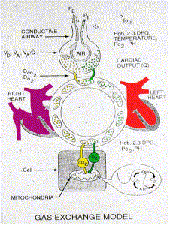
Figure 2 Graphical representation of the respiratory and circulatory systems.
This figure is a cartoon of the respiratory (breathing) and circulatory systems of our bodies. Oxygen is drawn into our lungs, crosses the alveolar membrane into the blood stream where it is carried within the hemoglobin molecule to very distant capillaries. There the oxygen transverses other tissues and eventually enters the cell. Within the cell it finally enters the mitochondria where it is used to oxidize sugars to produce the energy we use. At many points along this system, the process of oxygenation may be interrupted or embarrassed.
Breathing.
The first step in respiration involves breathing: Let's look at how we get air -- which hopefully contains oxygen -- into our bodies. Look at Figure 3, and note that there's a fairly large volume of air that simply fills up our airways and isn't involved at all in gas exchange: this is called "dead space." This dead air doesn't "count" in getting oxygen into our bodies, because it contains the same low amount of oxygen as does exhaled air. Each breath must exceed the volume of dead space by enough to bring in the oxygen we need (and to get rid of carbon dioxide).
Figure 3 A graph of inhalation and exhalation showing the initial dead space, the first part of each breath. (Same as fig 15.)
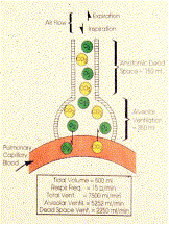
This three color drawing shows the normal person's breathing pattern. The darker green area on the left represents the first portion of each breath we take. That portion of the breath goes deepest into the lungs, right out to the alveolar walls where the air-blood interchange takes place. This is the part of our breath from which we extract oxygen, and represents only about 1/3 of each breath. The second portion, colored lighter green, represents the volume of air that we breath in that follows and fills the larger airways but does not take part in respiration. The yellow area is the exhaled gases, plotted against time.
Figure 4 Anatomical representation of the airway and lung showing ventilation and dead space. Same as fig 16.
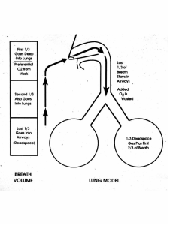
The first portion of the breath provides most of our oxygen delivery. As a breath begins, there already is air in the wind pipe and lungs equal to the last 1/3 of the previous breath. During the first third of the breath, this is sucked into the lungs. After inhalation, the air now out in the lungs at the air-blood interface is the residual portion of the last breath, diluted by the first third of the new breath. The last third of each breath only fills airways like the major wind pipes, and no oxygen is extracted from it. Based on this, where would you like to add additional oxygen? Clearly, in the first third of each breath, because it goes the deepest into the lungs and participates in gas exchange.
Figure 5 Oxygen entering the body and Carbon Dioxide leaving via the alveolus.
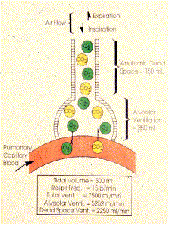
In this slide you see a model of the alveolus, its capillary and gases as represented by green for oxygen molecules and yellow for carbon dioxide. Of all the air that enters the lung only the air adjacent to the alveolar-capillary junction participates in gas exchange.
Figure 6: The ventilation-circulatory interface in normal and in some disease states.
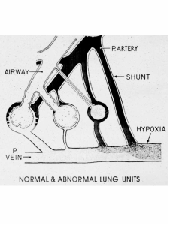 Unfortunately
the lung and pulmonary circulation are not perfect. There are differences in
the amount of blood and air going to different areas of the lung. These may
be physiologic, meaning normal or pathologic, meaning due to disease. As an
example, while you are sitting in your seats more blood is doing to the bases
of your lungs and more air is going to the tops or apices. This produces a
relative mismatch of air and blood. But on the average it works out fine.
Shown here are four variations of a constant spectrum. From left to right,
are normal, lots of air and very little blood, very little air and finally
lots of blood and no air at all where the blood already somewhat depleted of
oxygen and darker red essentially bypasses the lung.
Unfortunately
the lung and pulmonary circulation are not perfect. There are differences in
the amount of blood and air going to different areas of the lung. These may
be physiologic, meaning normal or pathologic, meaning due to disease. As an
example, while you are sitting in your seats more blood is doing to the bases
of your lungs and more air is going to the tops or apices. This produces a
relative mismatch of air and blood. But on the average it works out fine.
Shown here are four variations of a constant spectrum. From left to right,
are normal, lots of air and very little blood, very little air and finally
lots of blood and no air at all where the blood already somewhat depleted of
oxygen and darker red essentially bypasses the lung.
Figure 7 Common types of hypoxia that should be recognized.
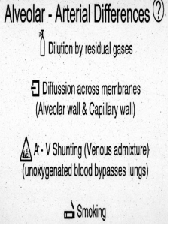 Various
disease states including the more common ones of asthma and smoking cause such
changes. What has to be considered is that the lung is an inefficient organ
at best but is wonderfully efficient in that it keeps us living for many
years. In essence it does a job of self regulation providing oxygen to the
blood stream to nourish our bodies. Compared to the amount of oxygen in the
lungs, the level of oxygen in the blood stream lags the lungs by approximately
10%. Some of the factors causing this are listed on this slide. Remember the
residual gas left in the lungs and airway before the next breath, this causes
some dilution as well as does humidification (addition of water) and carbon
dioxide excretion. For oxygen to get into the bloodstream it has to cross
several membranes. That is not particularly easy for an insoluble gas.
Certain disease states increase the amount of shunting (bypassing), that is
allowing unoxygenated blood to bypass the lung. Lastly, smoking has a
tremendous effect upon the normal lung by causing constriction of the airways,
destruction of alveolar walls and gas exchange surface and drastically
increasing the shunting mentioned before.
Various
disease states including the more common ones of asthma and smoking cause such
changes. What has to be considered is that the lung is an inefficient organ
at best but is wonderfully efficient in that it keeps us living for many
years. In essence it does a job of self regulation providing oxygen to the
blood stream to nourish our bodies. Compared to the amount of oxygen in the
lungs, the level of oxygen in the blood stream lags the lungs by approximately
10%. Some of the factors causing this are listed on this slide. Remember the
residual gas left in the lungs and airway before the next breath, this causes
some dilution as well as does humidification (addition of water) and carbon
dioxide excretion. For oxygen to get into the bloodstream it has to cross
several membranes. That is not particularly easy for an insoluble gas.
Certain disease states increase the amount of shunting (bypassing), that is
allowing unoxygenated blood to bypass the lung. Lastly, smoking has a
tremendous effect upon the normal lung by causing constriction of the airways,
destruction of alveolar walls and gas exchange surface and drastically
increasing the shunting mentioned before.
Let's now leave physiology and investigate some of the physical world around us.
Figure 8: A table of partial pressures of gases at various altitudes with the corresponding oxygen pressure of the atmosphere and the blood oxygen saturation that would occur in a pilot.
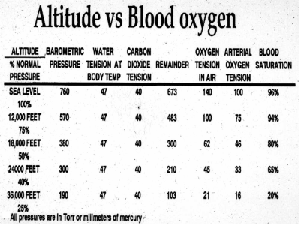
Let's turn our attention to the atmosphere in which we fly. This figure depicts on the left, altitude and the percent of the atmosphere above our heads. For instance at 18,000 feet (5,500m) only 50% of the atmosphere is left, thus we are above 50% of the earth's atmospheric blanket. At 36,000 feet (11,000m) 75% of the atmosphere is below.
The next column represents the atmospheric pressure at each altitude in mm of Hg. We humidify the air we breathe and the vapor pressure of water at body temperature is 47 mm Hg, reducing proportionately the amount of oxygen available. In addition we excrete carbon dioxide as a metabolic waste product. The carbon dioxide level in our blood is virtually constant, regulated by our brains, to 40 mm Hg. The air we breathe in is diluted by humidification (47 mmHg) and by the carbon dioxide excreted into it (40mm Hg).
The oxygen has already been diluted by the residual air from the previous breath. Column 5 shows the pressure after this 87 mm Hg is subtracted from the atmospheric pressure Column 6 shows the oxygen pressure assuming the usual oxygen content of 21%. Column 7 shows the pressure of oxygen after the process of transferring it into the blood stream.
You can see from this table that at altitude, oxygenation can be significantly lower than desired. For example, compared to sea level only one third the amount of blood oxygen should be available at 24,000 feet (7250m).
The last column lists oxygen saturation. This indicates how far the oxygen cells are from being saturated with oxygen at any particular altitude. This is the important number that relates to function: in the low 80's %, you've lost some IQ points and in the 60's% the rest of your cells aren't working so well, either.
Figure 9: Oxygen needs for altitudes.
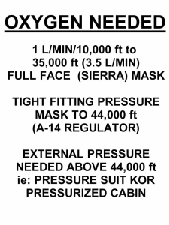 The
aviation community, in the late 1930's and early 1940's, obtained data upon
which a guide specifying the rate of supplemental oxygen needed for altitude,
which is:
The
aviation community, in the late 1930's and early 1940's, obtained data upon
which a guide specifying the rate of supplemental oxygen needed for altitude,
which is:
· 1 l/min @ 10,000 feet (3,000m) to 35,000 feet (10,000m) (3.5 l/min).
· Tight fitting pressure mask to 44,000 feet (13,500m) (A-14 regulator); external pressure is needed.
· Above 44,000 feet (13,500m) a pressure suit or a pressurized cabin is necessary, because at this altitude the boiling point of blood is below body temperature. This causes a quick death.
Since very few of us will go above 35,000 feet (10,000m) or yet above 44,000 feet (13,500m) simple systems of oxygen delivery will suffice. There is only one pressurized sailplane known to me, it is in the Boeing Museum in Seattle, WA.
Illustrations of various oxygen systems.
Figure 10 A-14 system on, canopy closed.
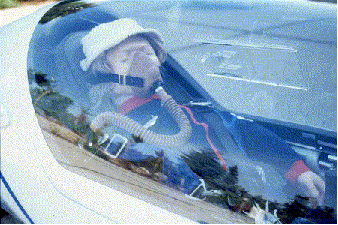
Figure 11: List of oxygen and environmental systems.
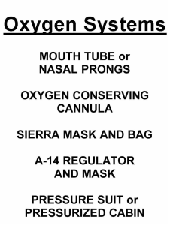
Basically, the present day oxygen systems fall into these five categories:
Mouth tube or nasal prongs
Oxygen conserving canula
Sierra mask and reservoir bag
A-14 regulator and mask (100% and pressure breathing)
Pressure suit or pressurized cabin
I enlisted Resusci Annie, (a CPR manikin) to demonstrate various systems.
Figure 12: Mouth tube.
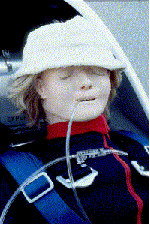 Here
you see Annie sitting in the cockpit with a simple tube in her mouth and a
ball flow regulator on her chest. This simple system is fairly good at levels
below 18,000 (5,500m) feet but should use flows of 1 l/min/10,000 feet
(3,000m) or almost 2 l/min at the maximum legal altitude of 18,000 feet (5,500m).
Here
you see Annie sitting in the cockpit with a simple tube in her mouth and a
ball flow regulator on her chest. This simple system is fairly good at levels
below 18,000 (5,500m) feet but should use flows of 1 l/min/10,000 feet
(3,000m) or almost 2 l/min at the maximum legal altitude of 18,000 feet (5,500m).
Figure 13: A-14 system.
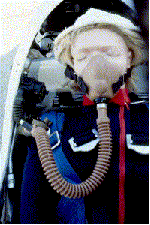 The
other extreme, available to us is an A14 system. A14's are overhauled Air
Force surplus. It is a system which will blend oxygen based upon altitude and
then begin to increase pressure against exhalation (breathing out) in order
to maintain sufficient oxygen pressure in the lungs. It is not automatic.
The
other extreme, available to us is an A14 system. A14's are overhauled Air
Force surplus. It is a system which will blend oxygen based upon altitude and
then begin to increase pressure against exhalation (breathing out) in order
to maintain sufficient oxygen pressure in the lungs. It is not automatic.
Figure 14: Oxygen-Conserving Canula.
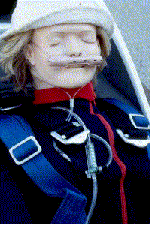 In
my experience, the conservation canula is the most commonly used oxygen unit.
It is approved by the FAA to use oxygen flows of only 30-50% of that required
by other systems up to an altitude of 18,000 feet (5,500m). Its magic will be
discussed below.
In
my experience, the conservation canula is the most commonly used oxygen unit.
It is approved by the FAA to use oxygen flows of only 30-50% of that required
by other systems up to an altitude of 18,000 feet (5,500m). Its magic will be
discussed below.
Figure 15: Inhalation-Exhalation volume graph showing Dead space, Same as Fig 3.
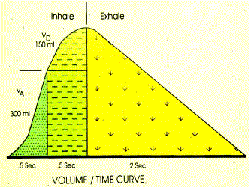 Remember
the breath-time diagram (Figure 3. If we want added oxygen to be used most
efficiently, we should add it to the very first portion of the breath so that
it reaches the furthest into the lungs, into the alveolar air sacks, next to
the capillaries. Any added oxygen added in late inhalation or exhalation will
not reach the capillaries and will be exhaled and wasted.
Remember
the breath-time diagram (Figure 3. If we want added oxygen to be used most
efficiently, we should add it to the very first portion of the breath so that
it reaches the furthest into the lungs, into the alveolar air sacks, next to
the capillaries. Any added oxygen added in late inhalation or exhalation will
not reach the capillaries and will be exhaled and wasted.
Figure 16: Total airway with respect to dead space and wasted ventilation.
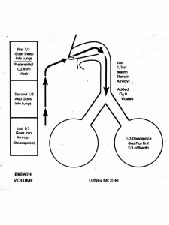 Let's
reconfirm that idea using the nose-windpipe model also seen earlier. If we
add oxygen to the first third of the breath it will go deeper into the lung,
whereas any oxygen added to the middle and especially the last thirds will
again be wasted.
Let's
reconfirm that idea using the nose-windpipe model also seen earlier. If we
add oxygen to the first third of the breath it will go deeper into the lung,
whereas any oxygen added to the middle and especially the last thirds will
again be wasted.
Figure 17: A hospital oxygen mask.
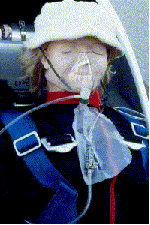 Here
is a mask and bag, it is much cheaper than a Sierra mask system. But don't
even think about using it! In the cold of altitude the bag will be so stiff
it won't fill because there is no valve on it. The mask fits very poorly and
the holes in the sides effectively make this system very inefficient. This
mask is designed for hospital use where flows of 10-15 l/min can be given
without much thought of cost or availability, its maximum oxygen concentration
is near 50% unless flows of 20 l/min or higher are used.
Here
is a mask and bag, it is much cheaper than a Sierra mask system. But don't
even think about using it! In the cold of altitude the bag will be so stiff
it won't fill because there is no valve on it. The mask fits very poorly and
the holes in the sides effectively make this system very inefficient. This
mask is designed for hospital use where flows of 10-15 l/min can be given
without much thought of cost or availability, its maximum oxygen concentration
is near 50% unless flows of 20 l/min or higher are used.
Figure 18: Hospital canula.
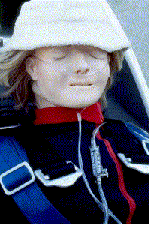 Let's
consider the standard canula. This is a very inexpensive item which can be
obtained very easily. In order to be effective it needs an oxygen flow of 1
l/min/10,000 (3,000m) feet in order to provide adequate oxygenation up to
18,000 feet. Refer back to the respiratory volume time curve (figure 3).
Consider that oxygen given during the later part of inspiration and throughout
exhalation is simply wasted.
Let's
consider the standard canula. This is a very inexpensive item which can be
obtained very easily. In order to be effective it needs an oxygen flow of 1
l/min/10,000 (3,000m) feet in order to provide adequate oxygenation up to
18,000 feet. Refer back to the respiratory volume time curve (figure 3).
Consider that oxygen given during the later part of inspiration and throughout
exhalation is simply wasted.
Figure 19: Mountain High's Electronic Delivery System (EDS).
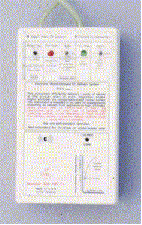 Mountain
High of Salt Lake City to the rescue. Patrick Mclaughlin has developed this
handy dandy EDS (Electronic Delivery System) oxygen regulator for use with the
standard canula. Basically it monitors your breathing by measuring pressure
changes at your nostril and when it determines the beginning of inspiration,
gives a blast of oxygen, the volume determined by an altitude sensor. It is
quite efficient and the little "puff" it emits with each breath
reassures you that the system is turned on and working.
Mountain
High of Salt Lake City to the rescue. Patrick Mclaughlin has developed this
handy dandy EDS (Electronic Delivery System) oxygen regulator for use with the
standard canula. Basically it monitors your breathing by measuring pressure
changes at your nostril and when it determines the beginning of inspiration,
gives a blast of oxygen, the volume determined by an altitude sensor. It is
quite efficient and the little "puff" it emits with each breath
reassures you that the system is turned on and working.
Figure 20: Oxygen-conserving canula plus a Nelson A-3 flow regulator.
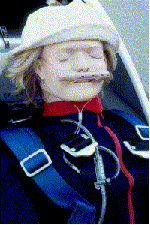 The
conserving canula has been quite popular in the Western US. It has two small
reservoirs totaling about 15 ml in the cheek pouches that fill during
exhalation from a constant flow of oxygen. The nasal prongs are larger than
those of the standard canula. This causes most of the oxygen to be delivered
during the first portion of the inspiratory (breathing in) phase empties the
reservoirs before entraining much ambient air. Thus, compared to the standard
canula, its effect has been tested up to 18,000 (5,500m) feet at significantly
lower oxygen flows resulting in adequate oxygenation.
The
conserving canula has been quite popular in the Western US. It has two small
reservoirs totaling about 15 ml in the cheek pouches that fill during
exhalation from a constant flow of oxygen. The nasal prongs are larger than
those of the standard canula. This causes most of the oxygen to be delivered
during the first portion of the inspiratory (breathing in) phase empties the
reservoirs before entraining much ambient air. Thus, compared to the standard
canula, its effect has been tested up to 18,000 (5,500m) feet at significantly
lower oxygen flows resulting in adequate oxygenation.
The flow meter on Annie's chest produces flows of about 500 ml/min/10,000 feet (3,000m), and is calibrated up to 18,000 feet (5,500m).
Figure 21: Nelson A-3 regulator (600cc/min at 18,000 feet).
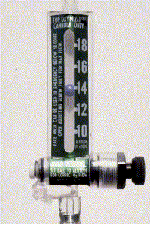
Figure 22: A graph based upon mathematical representations of our bodies' ability to use the oxygen presented at altitude. It is graphed both as "no added oxygen" and as "oxygen delivered by an oxygen-conserving canula" using the Nelson (TM) A-3 regulator (600cc/min @ 18,000 feet delivery rate).
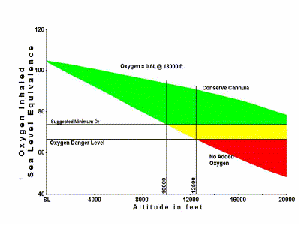 This
graph, colored to indicate safe, cautionary, and danger areas, represents the
mathematically derived blood oxygen delivered at altitude from ambient air
using a conserve canula. The ordinate (vertical line) is the percentage of
sea level oxygen delivered at respective altitudes. Without supplementation
your oxygenation would be marginal at 9-10,000 feet (2,700-3,000m) and
dangerous above 12,500 feet (3,750m). While using the conservation canula the
safe zone is above 20,000 feet (6,000m).
This
graph, colored to indicate safe, cautionary, and danger areas, represents the
mathematically derived blood oxygen delivered at altitude from ambient air
using a conserve canula. The ordinate (vertical line) is the percentage of
sea level oxygen delivered at respective altitudes. Without supplementation
your oxygenation would be marginal at 9-10,000 feet (2,700-3,000m) and
dangerous above 12,500 feet (3,750m). While using the conservation canula the
safe zone is above 20,000 feet (6,000m).
[Insert here FAR on oxygen mask use]
Figure 23: Sierra Mask and Nelson A-4 flow regulator.
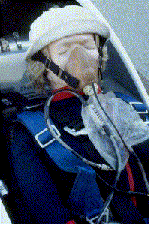 The
next step up in efficiency is the Sierra mask system. This is a tight fitting
mask with a head strap and a reservoir bag. Notice the pale rings at the mask
bag juncture. Located there are valves that require the deflation of the bag
prior to entrainment (adding in) of outside air. Additionally, exhaled air is
prevented from filling the bag and there is slight resistance to venting
exhaled air. One note of caution, don't expect the bag to fill visibly. Below
20,000 feet (6,000m) the oxygen flow does not seem to expand the bag. At
higher altitudes, 30,000 feet (9,000m) and above, it becomes quite obvious
that the bag is filling. This mask system is useful up to the high 30 thousands.
The
next step up in efficiency is the Sierra mask system. This is a tight fitting
mask with a head strap and a reservoir bag. Notice the pale rings at the mask
bag juncture. Located there are valves that require the deflation of the bag
prior to entrainment (adding in) of outside air. Additionally, exhaled air is
prevented from filling the bag and there is slight resistance to venting
exhaled air. One note of caution, don't expect the bag to fill visibly. Below
20,000 feet (6,000m) the oxygen flow does not seem to expand the bag. At
higher altitudes, 30,000 feet (9,000m) and above, it becomes quite obvious
that the bag is filling. This mask system is useful up to the high 30 thousands.
Figure 24: Nelson A-4 flow regulator (1L/mim/10,000 feet).
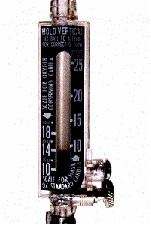 Notice
the two scales: the right is 0-25 or 25,000 feet (7,500m) and is calibrated
for a flow of 1 l/min/10,000 feet 3,000m). The left scale is similar to that
used with the conservation canula. The sierra mask system is as efficient as
the conservation canula, probably even more so, but is designed to be used
above 18,000 feet (5,500m).
Notice
the two scales: the right is 0-25 or 25,000 feet (7,500m) and is calibrated
for a flow of 1 l/min/10,000 feet 3,000m). The left scale is similar to that
used with the conservation canula. The sierra mask system is as efficient as
the conservation canula, probably even more so, but is designed to be used
above 18,000 feet (5,500m).
Figure 25: Military A-8 oxygen system and Sierra Mask with microphone.
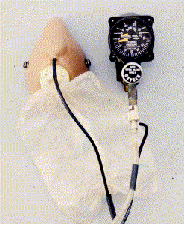 Another
frequently used method of regulating the oxygen flow is the A8 regulator.
Also an Air Force hand me down, these regulators are very susceptible to
maladjustment and flow errors. Frequently, these units are red tagged by a
maintenance shops, thus becoming paper weights. Their advantage is that they
are easily adjustable with a readout in thousands of feet.
Another
frequently used method of regulating the oxygen flow is the A8 regulator.
Also an Air Force hand me down, these regulators are very susceptible to
maladjustment and flow errors. Frequently, these units are red tagged by a
maintenance shops, thus becoming paper weights. Their advantage is that they
are easily adjustable with a readout in thousands of feet.
Figure 26: This is Figure 22 taken to a more extreme altitude comparing "no oxygen" to a full fitting face mask with constant flow reservoir bag (Sierra Mask system) and a delivery rate of 1.0L/min/10,000 feet.
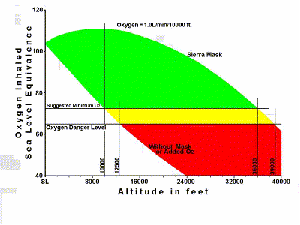 Here
is a similar curve this time based on the sierra mask system. Again it is a
mathematically calculated curve. Again the no oxygen curve enters the caution
range at 9-10,000 feet (2,700-3,000m) and the red range at 12,500 feet
(3,750m). In contrast, the Sierra mask when used correctly, enters the
caution range about 36,000 feet (11,000m) and the danger area at about 39,000
feet (12,000m). I have personally used this system over 37,000 feet (11,500m).
Here
is a similar curve this time based on the sierra mask system. Again it is a
mathematically calculated curve. Again the no oxygen curve enters the caution
range at 9-10,000 feet (2,700-3,000m) and the red range at 12,500 feet
(3,750m). In contrast, the Sierra mask when used correctly, enters the
caution range about 36,000 feet (11,000m) and the danger area at about 39,000
feet (12,000m). I have personally used this system over 37,000 feet (11,500m).
Figure 27: The Altox system.
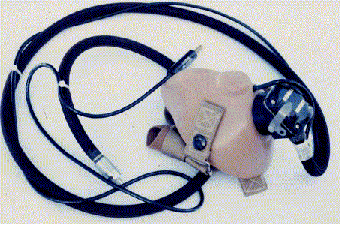 The
Altox system. uses a pressurized supply between 20 and 60 pounds per square
inch. The black body attached to the nose of the mask is a regulator which is
sensitive to mask pressures produced by breathing. It is not very efficient
in that it requires constant oxygen except for a small blend hole on the side
by the silver lever. I am interested in paperwork and documentation on this
unit. Unfortunately, to this date I have not been able to locate any. If any
one has documentation, please send copies to Dr. Lipe.
The
Altox system. uses a pressurized supply between 20 and 60 pounds per square
inch. The black body attached to the nose of the mask is a regulator which is
sensitive to mask pressures produced by breathing. It is not very efficient
in that it requires constant oxygen except for a small blend hole on the side
by the silver lever. I am interested in paperwork and documentation on this
unit. Unfortunately, to this date I have not been able to locate any. If any
one has documentation, please send copies to Dr. Lipe.
Figure 28: The oxygen system in my glider.
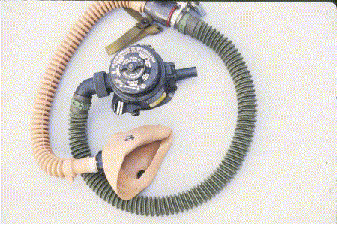 This
is the venerable A14 system. These are surplus military units. On the face
is a dial to change the oxygen concentration and back pressure so that it can
be used to 44-45,000 feet (13,500). Above 39,000 feet (12,000m) the unit
produces resistance to exhalation so that in the low 40 thousands it is
somewhat difficult to breathe. It is like trying to breathe with an air
compressor in one's mouth.
This
is the venerable A14 system. These are surplus military units. On the face
is a dial to change the oxygen concentration and back pressure so that it can
be used to 44-45,000 feet (13,500). Above 39,000 feet (12,000m) the unit
produces resistance to exhalation so that in the low 40 thousands it is
somewhat difficult to breathe. It is like trying to breathe with an air
compressor in one's mouth.
Figure 29: Military A-14 system.
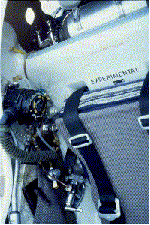 This
is a Glaser-Dirks which has been equipped with a dual oxygen system. There
are two bottles and each has its primary regulator adjusted so that they will
work in a cascade system. In addition, there are secondary regulators for
constant flow systems, regulators for higher pressure systems such as the
Altox and EDS from mountain high and an A14 system. Essentially each system
can work off of either tank automatically. This was Dr. Lipe's fun ship and
test bed.
This
is a Glaser-Dirks which has been equipped with a dual oxygen system. There
are two bottles and each has its primary regulator adjusted so that they will
work in a cascade system. In addition, there are secondary regulators for
constant flow systems, regulators for higher pressure systems such as the
Altox and EDS from mountain high and an A14 system. Essentially each system
can work off of either tank automatically. This was Dr. Lipe's fun ship and
test bed.
Figure 30: Graph of the study of Nelson flow systems during developmental testing.
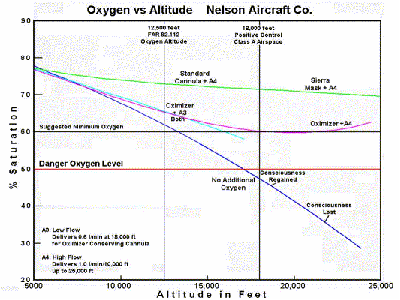 Several
years ago during the development of the Nelson A3 low flow regulator, Dr. Lipe
accompanied Ted Nelson and his son Jerry and a pilot on a data gathering
flight to 24,000 feet (7,250m). Several systems were evaluated as are shown
in this chart. The measurements were accomplished by an oximeter, a device
which uses photocells to measure the color of the capillary blood by spectral
absorption at 600 and 630 milli-microns. Altitude was called out by the
pilot. Ted Nelson was the recorder and Jerry was the guardian. Dr. Lipe was
the guinea pig.
Several
years ago during the development of the Nelson A3 low flow regulator, Dr. Lipe
accompanied Ted Nelson and his son Jerry and a pilot on a data gathering
flight to 24,000 feet (7,250m). Several systems were evaluated as are shown
in this chart. The measurements were accomplished by an oximeter, a device
which uses photocells to measure the color of the capillary blood by spectral
absorption at 600 and 630 milli-microns. Altitude was called out by the
pilot. Ted Nelson was the recorder and Jerry was the guardian. Dr. Lipe was
the guinea pig.
The first climb to 24,000 feet (7,250m) was done as a control, without added oxygen. This resulted in Dr. Lipe losing consciousness. Previously he had been to 24,000 (7,250m) feet, without added oxygen, in altitude chambers, without adverse effect. The last event Dr. Lipe remembers was 22,000 feet (6,750m). After reaching 24,000 feet (7,250m) the pilot started down and Dr. Lipe woke up at about 19,000 feet (5,750m). According to Jerry Nelson, Dr. Lipe still acted normally, although his speech was a little slurred. The middle curve was accomplished using a conserve canula and an early A3 flow regulator to 18,000 (5,500m) and then switching to an A4 regulator above that. The top curve was a standard canula using an A4 regulator to 18,000 (5,500m) and then a Sierra mask above that. Obviously the top curve is best. It was felt that the middle curve was marginal. Based on this data, the A3 flow regulator was modified to increase delivery volume at higher altitudes by about 25% before it was put on the market.
Figure 31: Portable oximeter (left) and recording barometer used in the recording of data.
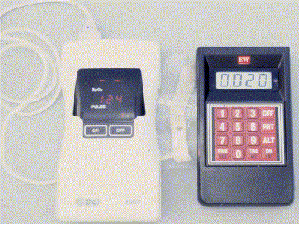 Today
the measurement of oxygen saturation and altitude is easy. This little
oximeter on the left -- a DCI 3301 -- can be put in a pocket and the barograph
on the right is of similar size. Each will record into memory the flight
data. The data only needs to be down loaded and matched for time.
Today
the measurement of oxygen saturation and altitude is easy. This little
oximeter on the left -- a DCI 3301 -- can be put in a pocket and the barograph
on the right is of similar size. Each will record into memory the flight
data. The data only needs to be down loaded and matched for time.
Figure 32: Oxygen-Hemoglobin dissociation curve.
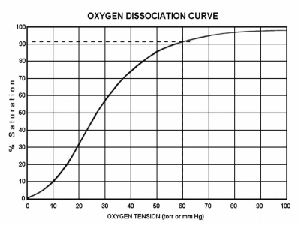 As
mentioned before, oxygen saturation is not linearly related to oxygen tension.
This is because the hemoglobin molecule has a changing affinity for oxygen.
The equipment Dr. Lipe uses to measure oxygen measures saturation. This needs
to be converted into oxygen tension for our use. Essentially, the steepness
of this curve corresponds to hemoglobin's ability to release oxygen. For
instance, between the oxygen tensions of 20 and 30 more oxygen is released
than between 60 and 70. Incidentally, at sea level, the use of 100% oxygen
only increases blood carried oxygen by three tenths of one percent. At
altitude when our saturation is lower extra oxygen is very beneficial.
As
mentioned before, oxygen saturation is not linearly related to oxygen tension.
This is because the hemoglobin molecule has a changing affinity for oxygen.
The equipment Dr. Lipe uses to measure oxygen measures saturation. This needs
to be converted into oxygen tension for our use. Essentially, the steepness
of this curve corresponds to hemoglobin's ability to release oxygen. For
instance, between the oxygen tensions of 20 and 30 more oxygen is released
than between 60 and 70. Incidentally, at sea level, the use of 100% oxygen
only increases blood carried oxygen by three tenths of one percent. At
altitude when our saturation is lower extra oxygen is very beneficial.
Figure 33: This figure represents a flight without supplemental oxygen. The scatter of the data points demonstrates the variability of the measurement system used; the blue line is a line of best fit, showing that the data have the expected relationship between oxygen saturation and altitude.
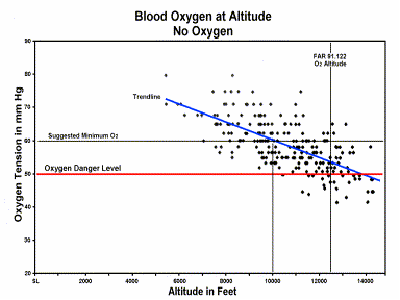
Here Dr. Lipe has plotted several flights below 18,000 feet (5,500m) using the ordinate for blood oxygen tension and the abscissa for altitude. Included is a trend analysis line. Please note the relationship of the trend line to altitude. It crosses the danger level, that level where thought and decision processes begin to be compromised, about 12,500 feet (3,000m). Also the line crosses what Dr. Lipe consider to be the top of the yellow caution area about 10,000 feet (3,000m). This data is in support of the mathematical model without oxygen.
Figure 34: This figure represents a 4 hour flight from Truckee into wave south of Minden and was purposely limited to 24,000 feet. It was a series of 4 climbs during that time from 14,000 to 24,000 then back down to 14,000 and then over again 3 more times. At the end of the flight Dr. Lipe went back to Truckee and passing through 12,500 feet removed my nasal canula. The figure shows the data points and a third-order curve of best fit. Dr. Lipe was very curious why there were data points below 12,500 and below 50 mm torr oxygen tension. Dr. Lipe thought that they were bad data, but in reviewing the data carefully, Dr. Lipe discovered that most of the bad points were at the end of the flight, during the final phase of the descent.
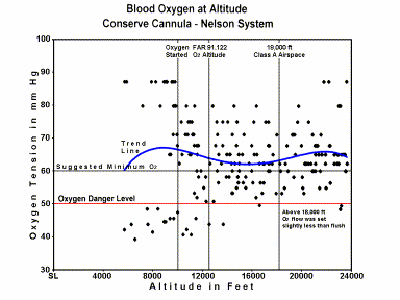
This graph also shows oxygen vs altitude but this time Dr. Lipe used a nasal canula and a Nelson A3, flow regulator to 24,000 feet (6,000m).
The trend line shows a bimodal curve which distressed him when Dr. Lipe first saw it. This data was collected during a 3 1/2 hour flight from Truckee and into wave just west of Minden. It provided three separate climbs from 10,000 feet to 24,000 feet (3,000-7,600m) before returning to Truckee. The A3 flow regulator was set according to the altitude except above 18,000 feet (5,500m) when it was set to just less than flush. Notice that the system behaves very similarly to the mathematical model for the conserve canula showing it effective to the middle 20 thousand foot (6,000m) level. As Dr. Lipe mentioned before, Dr. Lipe was bothered by the bimodal trend line. A little investigation revealed that all 16 points in the lower left group were made during the last 16 minutes of the flight. You will also notice that they are all below 12,500 feet (3,750m) in altitude. For one reason or another Dr. Lipe had removed the oxygen system passing through 12,500 feet (3,750m) while returning to home base.
Figure 35: The same plot as Fig 33, but with the last 7 1/2 minutes of data (the time it took him to descend from 12,500 feet to the termination of the landing and roll out) removed. Note that the line of best fit, with the data points below 12,500 feet at the endive the flight deleted, shows a second order curve as expected.
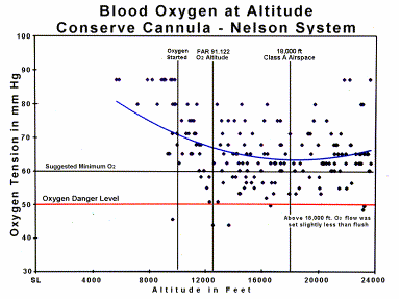
Now the problem arises as to why were the aberrant points as they were? What is baffling is why all the points after removing the oxygen canula were so depressed. If you refer to figure 33, Dr. Lipe should have been in the range of 54 to 70 torr oxygen not the 40-50 torr range.
The problem is - Why are all the pre-landing points below 50 torr without exception. If this were purely due to measurement scatter, at least SOME of them should be above 50 torr!
When these points are removed the new trend line is now of a much different character. It starts high at lower altitudes and curves down to around 16,000- 24,000 feet (4,900-7,600m) as would be expected.
Figure 36: The same as fig 34, but the points on the descent below 12,500 are red tagged. In Figs. 33 - 36 The fairly wide scatter of points is primarily measurement error due to probe movement, skin temperature, etc.
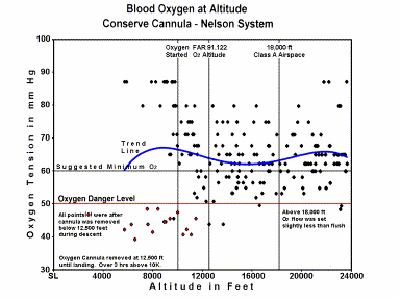
In this slide the offending last 16 points, all below 12,500 (3,750m) are marked. As Dr. Lipe said these points represent all data during the final 16 minutes of the flight, the altitude was less than 12,500, feet (3,750m) during which time Dr. Lipe was entering the traffic pattern and making my approach to landing. Dr. Lipe do not remember feeling different, although Dr. Lipe am usually quite aware of my individual hypoxic symptoms. The real question arises, had Dr. Lipe known of my relative hypoxia should Dr. Lipe have been on added oxygen? The answer is a definite YES! But the question still remains, why are all these data, without exception, aberrant, when for all rightful purposes they should not have been? My only explanation is that although Dr. Lipe was apparently well oxygenated at altitude, might my bodily oxygen stores have been compromised? Did the removal of extra oxygen passing through 12,500 feet (3,750m) suddenly expose him to the decreased stores and allow my arterial oxygen to fall to what Dr. Lipe considers a dangerous level. The only caveat is to do what was advocated many years ago, that is, once using oxygen continue it until roll out stops.
Figure 37: Stress of flying on a time linear scale during a flight. Dr. Lipe recommends that you leave oxygen on until you have landed and stopped. If the aberrant points of fig 36 are valid, then considering the stress level of landing and the time/exhaustion factor breathing an increased-oxygen atmosphere may well be the best thing to do in the most critical part of the flight.
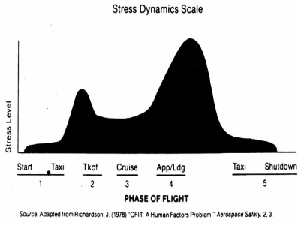
Don't forget that you are tired, probably dehydrated, entering the airport traffic area and proceeding to a landing, all actions together, probably, the most dangerous part of the flight and hypoxic as well. At this time our thought processes and judgment patterns need to be the sharpest since we took off.
Now I'll finish with a thought the philosophers have pondered for years. If nobody is around to hear a meteor crash in the forest, does it really make noise? Or, to put that in glider terms; does it really hurt when you hit the ground if you are asleep?
Experience is a wonderful thing
It allows you to recognize a mistake
When you make it again
slipe@earthlink.net